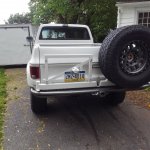Ouiwee
Observer
I got the rear rack back from paint and installed. Notice the titanium bolts that hold on the license plate--just like the bolts on the fender flares. I might swap out the ordinary stainless bolts that hold the rack on as well just to be stupid.


I turned some spacers out of delrin to make up the difference between the 1.5" tube and the bottom 2" tube.

The rack can hold other things as well.

I intend to add a hinged aluminum plate on the back side of the swing-out that drops down when the swing-out is open. It can be used for a work surface, someplace to put a stovetop, and so on. I started working on a flat panel that will use the same bolt holes and hold the license plate and light. I should have that sorted out this weekend.
I have to work out the locking bar that slides through the tabs on top. Some 7075 aluminum might work well. The rack is really light and holds my weight without too much flex.
The AC is flushed, lubricated, and reassembled. It held 25 inches of vacuum over night. The weekend should see cold air blowing in the cab. This thing is really coming together.


I turned some spacers out of delrin to make up the difference between the 1.5" tube and the bottom 2" tube.

The rack can hold other things as well.

I intend to add a hinged aluminum plate on the back side of the swing-out that drops down when the swing-out is open. It can be used for a work surface, someplace to put a stovetop, and so on. I started working on a flat panel that will use the same bolt holes and hold the license plate and light. I should have that sorted out this weekend.
I have to work out the locking bar that slides through the tabs on top. Some 7075 aluminum might work well. The rack is really light and holds my weight without too much flex.
The AC is flushed, lubricated, and reassembled. It held 25 inches of vacuum over night. The weekend should see cold air blowing in the cab. This thing is really coming together.






















